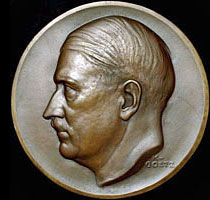|
 It is a known fact that Goetz made at least 140 medals from 1933 to 1945, not all political; many were private issues and many others were non-political pieces. While the glorification of Hitler was certainly not the theme for the majority of these medals, the subject was used enough to raise the question: Did Goetz sympathize with the new rulers in their quest for power? Did he subscribe to the Nazi motto: "Might is right, power is virtue; the greatest sin is weakness?" These questions are legitimate and can only be fully and satisfactorily answered by Karl Goetz himself. It is a known fact that Goetz made at least 140 medals from 1933 to 1945, not all political; many were private issues and many others were non-political pieces. While the glorification of Hitler was certainly not the theme for the majority of these medals, the subject was used enough to raise the question: Did Goetz sympathize with the new rulers in their quest for power? Did he subscribe to the Nazi motto: "Might is right, power is virtue; the greatest sin is weakness?" These questions are legitimate and can only be fully and satisfactorily answered by Karl Goetz himself.
We are fortunate that Gunter Kienast located, and translated, a six page hand-written document by Goetz to explain, almost as a justification, his work during the period of the Third Reich..
Goetz states that he was not a member of the Nazi Party, nor did he have any sympathies for any Party in Germany. Several times during the Nazi regime he was urged to join the Nazi Party, but even alluring offers of professorship's and other titles could not induce Goetz to sign. His son, Guido, wrote in 1966, "...the accusation that my father was an outrider of the Nazis would make him turn over in his grave even today!"
|
|
There have been claims by others that Goetz "accepted the New Order as inevitable and desirable" which, for most Germans, may have been true, at first. Anything was better than the Communists, or the continuation of the Brüning regime with its "emergency decrees" (Notverordnungen). Before Hitler came into power Germany had the highest suicide rate in its history, millions of people were unemployed, the economy was in shambles. Hitler and his party seemed to offer hope although it was not long before the Mephistophelian character of the new regime became apparent to many Germans.
|
|
Goetz, as any artist under a dictatorship not aligned with the new powers, had two survival strategies he could choose from: he could either leave Germany and immigrate to another country, or he could stay in Germany under the overtly watchful eye of the Nazi's. He chose the latter knowing full well that by doing so he would certainly be expected to become compliant in order for him, with his family, to survive. He seems to have paid a heavy toll for his decision to live under the dictatorship as his remaining creations, from this period through his last medal in 1946, were created and executed more as a matter of necessity rather than inspiration. His work was never again the caliber of his pre-Nazi days in Munich.
|